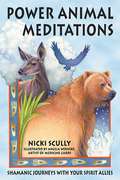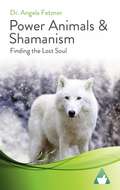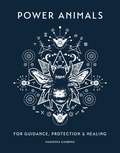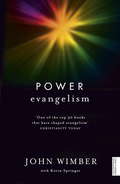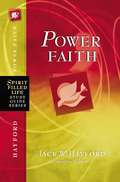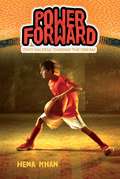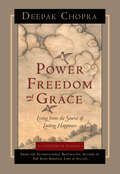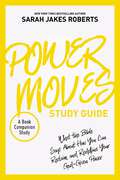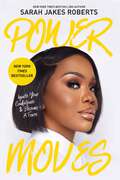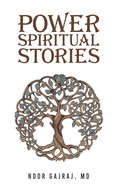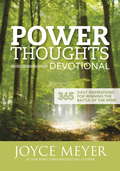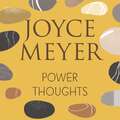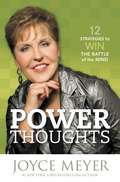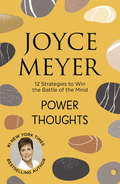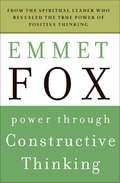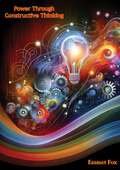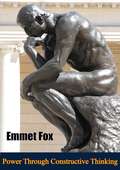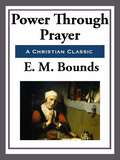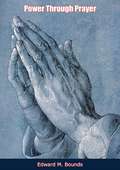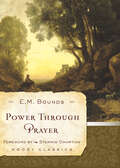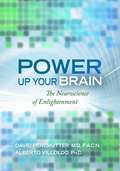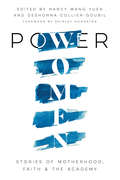- Table View
- List View
Power Animal Meditations: Shamanic Journeys with Your Spirit Allies
by Nicki Scully Angela WernekeA collection of guided journeys and meditations to help the reader connect with and learn from power animals and spirit allies.• 50 unique power animal and spirit guide meditations • Illustrated by the award-winning artist of Medicine Cards, Angela Werneke• 7 additional journeys going to new levels added since first edition What can the hawk teach you about your life purpose? What does the salmon know of fertile dreams, goal setting, and self actualization? Calling upon the magical wisdom of nature, Nicki Scully guides us into the spirit world of sacred totems, oracles, and animal teachings from many cultures, including Africa, Egypt, and North America. Encounter the archetypal wisdom teachings of Cobra, Eagle, Dolphin, Lioness, White Buffalo, Coyote, Cedar Tree, and many others. Each totem is exquisitely illustrated by Angela Werneke, the award-winning illustrator of Medicine Cards.
Power Animals & Shamanism: Finding the Lost Soul
by Dr Angela FetznerRegaining a lost soul In this book, the millennia-old healing techniques of shamanism are presented clearly and appealingly. The book is meant to give readers an overview of the complex and manifold facets of shamanism and to encourage them to reach out to their respective power animal. Power animals – spiritual companions and leaders Power animals are spiritual companions and soulmates, and each has a personal relationship with its human counterpart, who is thereby empowered, energized, deepened and motivated. The person is enabled to find his or her true purpose, to develop more fully and to avoid pitfalls, is protected, kept healthy and even healed, and can turn to the animal for help at any time. The more he or she does so, the more intense their partnership becomes. Some partnerships last a lifetime. How do you find your power animal? This book explains how to find, honor and bond with your power animal and thereby be strengthened and healed. It explains how the animal may be lost and how the loss may be averted. The main power animals The most important power animals and their meaning and message for humans are discussed in detail, revealing what positive qualities may be transferred from one to you. The worldview of shamanism This book offers all key information about shamanism and how to use it. The division of the shamanic cosmos into the upper, middle and lower worlds is explained, as are details of shamanic journeys. The role of the master of animals in particular is examined, as is the difference between spirit helpers and totem animals. The basic features of neo-shamanism are shown too. The shaman’s career Shamans are mediators between worlds. They have a special spiritual power, can change their state of consciousness at will and are sent into trance mostly by drumbeats. Power animals in ancient Egypt<br
Power Animals: For Guidance, Protection and Healing
by Madonna GaudingIf you have never heard of spirit animals or power animals, you have come to the right place.Featuring exercises and step-by-step instructions to help you access the power of animals as guides and healers. Includes a comprehensive directory explaining the symbolism and significance of 75 animals of land, sea and sky as well as mystical creatures.In Native American, Aboriginal and other shamanic cultures, animals have long been recognized as possessing important strengths and powers. This beautifully illustrated book will teach you how to discover which animal guide has the most to offer you, and provides practical exercises for working with your spirit animal's healing powers and wisdom. You will find step-by-step instructions for animal meditations, guidance on interpreting animal signs and messages and learn how to work with animal dreams and visions.As you begin the journey of discovering you own power animal, you will be reminded that you inhabit a vast, interconnected universe. This profound realization is one of the best antidotes to depression and alienation. By working with power animals, through meditation, visualization and direct contact, you will be able to ask your power animal for advice, guidance, protection and healing.
Power Animals: For Guidance, Protection and Healing
by Madonna GaudingIf you have never heard of spirit animals or power animals, you have come to the right place.Featuring exercises and step-by-step instructions to help you access the power of animals as guides and healers. Includes a comprehensive directory explaining the symbolism and significance of 75 animals of land, sea and sky as well as mystical creatures.In Native American, Aboriginal and other shamanic cultures, animals have long been recognized as possessing important strengths and powers. This beautifully illustrated book will teach you how to discover which animal guide has the most to offer you, and provides practical exercises for working with your spirit animal's healing powers and wisdom. You will find step-by-step instructions for animal meditations, guidance on interpreting animal signs and messages and learn how to work with animal dreams and visions.As you begin the journey of discovering you own power animal, you will be reminded that you inhabit a vast, interconnected universe. This profound realization is one of the best antidotes to depression and alienation. By working with power animals, through meditation, visualization and direct contact, you will be able to ask your power animal for advice, guidance, protection and healing.
Power Evangelism
by John Wimber Kevin SpringerJohn Wimber's first book, POWER EVANGELISM describes the releasing of God's power today through signs and wonders to refresh, renew, heal and equip his people. Drawing from the teaching of the New Testament, with illustrations from his own experience, Wimber persuades us 'to yield control of our lives to the Holy Spirit, learning to hear and do his will, risking all we have to defeat Satan and to advance the kingdom of God'.
Power Faith: Balancing Faith in Words and Works (Spirit-Filled Life Study Guide Series)
by Jack HayfordHow can we grow stronger in faith in the midst of life's struggles and conflicts? The Bible is clear in its teachings on faith, and Power Faith helps readers discover what the Scriptures say about faith in the context of healing, miracles, restoration, salvation, prosperity, and suffering. As part of the Spirit-Filled Life Study Guide Series, this study offers a dynamic, yet balanced approach to understanding the power of biblical faith, demonstrating how readers can find the full assurance of faith in their own Christian walk.The Spirit-Filled Life® study guides are perfect companions to the New Spirit-Filled Life Study Bible or for use on their own. Their interactive approach offers an in-depth look at practical living in God's kingdom and challenges users to examine and live their daily lives in light of God's Word.Features include:12 lessons, plus an introduction to living a life of faithFoundational, practical helps like Kingdom Extras, Probing the Depths, and Word Wealth in each lesson
Power Forward: Power Forward; On Point; Bounce Back (Zayd Saleem, Chasing the Dream #1)
by Sally Wern Comport Hena KhanFrom the critically acclaimed author of Amina’s Voice comes the first book in an exciting new middle grade series about a fourth-grader with big dreams of basketball stardom. <P><P>Fourth grader Zayd Saleem has some serious hoop dreams. He’s not just going to be a professional basketball player. He’s going to be a star. A legend. The first Pakistani-American kid to make it to the NBA. He knows this deep in his soul. It’s his destiny. <P><P>There are only a few small things in his way. For starters, Zayd’s only on the D-team. (D stands for developmental, but to Zayd it’s always felt like a bad grade or something.) Not to mention, he’s a bit on the scrawny side, even for the fourth grade team. But his best friend Adam is on the Gold Team, and it’s Zayd’s dream for the two of them to play together. <P><P>His mom and dad don’t get it. They want him to practice his violin way more than his jump shot. When he gets caught blowing off his violin lessons to practice, Zayd’s parents lay down the ultimate punishment: he has to hang up his high tops and isn’t allowed to play basketball anymore. As tryouts for the Gold Team approach, Zayd has to find the courage to stand up for himself and chase his dream.
Power Freedom and Grace: Living from the Source of Lasting Happiness
by Deepak Chopra MD&“This book captures the essence of all of my talks over the last 20 years. It is the distillation of almost everything I have taught up to now.&” — Deepak ChopraDeepak Chopra considers the mystery of our existence and its significance in our eternal quest for happiness. Who am I? Where did I come from? Where do I go when I die? Chopra draws upon the ancient philosophy of Vedanta and the findings of modern science to help us understand and experience our true nature, which is a field of pure consciousness.When we understand our true nature, we begin to live from the source of true happiness, which is not mere happiness for this or that reason, but true inner joy. When we know who we are, we allow the universe to flow through us with effortless ease, and our lives are infused with power, freedom, and grace.
Power Moves Study Guide: What the Bible Says About How You Can Reclaim and Redefine Your God-Given Power
by Sarah Jakes RobertsTake Back Your PowerIf you're tired of the world stealing your confidence, it's time to tap into the power that God has promised to you. He still causes dry bones to live, turns ashes into beauty, and clothes His people with righteousness. The key is your connection with Him. He will infuse you with power as you authentically examine your experiences, realign your beliefs, and focus on Him.In the Power Moves Study Guide, bestselling author Sarah Jakes Roberts guides you through passages of Scripture, reflection questions, and exercises that will shift your mindset from feeling defeated to embracing your God-given identity and call on your life. Each of the six sessions explores the type of power that God wants to infuse into your life:power through connectionpower to get unstuckpower to be used by Godpower to engage in battlepower to see God movepower to change livesYou don't have to fake it 'til you make it anymore. You can experience God's power.Designed for use with Power Moves by Sarah Jakes Roberts.
Power Moves: Ignite Your Confidence and Become a Force
by Sarah Jakes RobertsInstant New York Times Bestseller!Unleash the superpower of being yourself. Sarah Jakes Roberts, bestselling author of Woman Evolve, will help you craft a language toward your issues with intentionality.Stripping our minds of the expectations that inundate our world has never been more difficult. One quick scroll of our phones and we're consumed by other people's projections of how we should be feeling or responding.The ability to determine your truth without judgment is the beginning of harnessing authentic power in Christ. When we do the work of embracing where we are, we create space for God's love to meet us in our most raw form and then polish us to shine like never before. Power does not lie in success, achievement, or performance. Power rests in humility, honesty, and the commitment to continuous growth.Power Moves will help you to qualify whether you're living life authentically or if you've found a way to maintain status quo. It will reveal the principles required to tap into the most powerful version of who you are, then lead you in how to introduce your authentic self to the world around you. Sarah will help yougive language to your changing needs,acknowledge and applaud your growth,refuse to bear the weight all at once or all alone, andrelease your power. Open your eyes to the way that God sees you and awaken your boldness to effect change in the world by living out the truth of who God says you are with confidence.
Power Spiritual Stories
by Noor GajrajThese one hundred stories, born from three decades of spiritual pursuit, were chosen for their profound impact. Stories can be life-changing. It is often said that the shortest distance between a human being and truth is a story. In a world filled with untruths, stories help us discern what to believe. They allow us to explore different thoughts, perceptions, and actions, encouraging us to adopt new attitudes and choices. They provide a new way to interact with the world and others. These stories possess a power beyond words, connecting deeply with the brain and touching the soul. They carry messages from God that illuminate darkness and bring transformation. Stories can shift our paradigms, stimulate new perspectives, and help us transcend the physical to go beyond apparent facts.
Power Thoughts Devotional: 365 Daily Inspirations for Winning the Battle of the Mind
by Joyce MeyerBased on Joyce Meyer's New York Times bestseller Power Thoughts, this devotional includes 365 opportunities to tap into God's power in your daily life by thinking and speaking His way. The POWER THOUGHTS DEVOTIONAL will provide you with life-changing declarations of truth, directly from God's Word, to think and speak over your life every day of the year. Proverbs 18:21 says, "Death and life are in the power of the tongue." Simply put, words are containers for power--positive or negative, creative or destructive. Therefore, it is imperative that you learn to think and speak on purpose, using the life-giving wisdom in God's Word. When you do, your life will never be the same! If you struggle with being negative, critical, or judgmental of people and situations, don't be discouraged. God wants to help you renew your mind to think and speak as He would. It won't happen overnight--but each day you will make progress as you choose power thoughts to be more like Jesus. It's time for you to experience and enjoy the life God created you to live, and Joyce wants to help you get there. You can do it with this devotional by learning how to think and speak power thoughts daily.
Power Thoughts Devotional: 365 daily inspirations for winning the battle of your mind
by Joyce Meyer'Where the mind goes, the man follows.' - Joyce MeyerThe groundbreaking principles of POWER THOUGHTS are now encapsulated in a 365 day devotional, which encourages you to expose negative thinking and learn to think in line with God's Word. Walk with Joyce day by day, as she demonstrates the twelve strategies that provide the antidote to every battle your mind faces. The POWER THOUGHTS DEVOTIONAL will teach you how you can control the way you think and make positive changes to your life.
Power Thoughts Devotional: 365 daily inspirations for winning the battle of your mind
by Joyce MeyerDrawing on the principles of the bestselling POWER THOUGHTS, this daily devotional shows us how to take control of our mind and positively affect every area of our lives.'Where the mind goes, the man follows.' - Joyce MeyerThe groundbreaking principles of POWER THOUGHTS are now encapsulated in a 365 day devotional, which encourages you to expose negative thinking and learn to think in line with God's Word. Walk with Joyce day by day, as she demonstrates the twelve strategies that provide the antidote to every battle your mind faces. The POWER THOUGHTS DEVOTIONAL will teach you how you can control the way you think and make positive changes to your life.(P)2013 Hachette Audio
Power Thoughts: 12 Strategies to Win the Battle of the Mind
by Joyce MeyerJoyce Meyer has a knack for coining phrases-her fans call them Joyceisms-and one of her best loved is "Where the mind goes, the man follows." This was the basis for Battlefield of the Mind, and in her latest book, Meyer provides "power thoughts," bringing the reader to a new level of ability to use the mind as a tool to achievement.In POWER THOUGHTS, she outlines a flexible program to turn thoughts into habits, and habits into success. Sections include: · The Power of a Positive You · 5 Rules for Keeping Your Attitude at the Right Altitude · More Power To You bulleted keys to successful thinking in each chapter · The Power of PerspectiveNobody has more of a "can-do" attitude than Joyce Meyer. Now you can, too.
Power Thoughts: 12 Strategies to Win the Battle of the Mind
by Joyce MeyerJoyce Meyer has a knack for coining phrases - her fans call them 'Joyceisms' - and one of her best loved is 'Where the mind goes, the man follows.' This was the basis for BATTLEFIELD OF THE MIND, and in her latest book, Meyer provides 'power thoughts', bringing the reader to a new level of ability to use the mind as a tool to achievement.In POWER THOUGHTS, she outlines a flexible program to turn thoughts into habits, and habits into success. Sections feature bulleted keys to successful thinking in each chapter and include:The Power of a Positive You5 Rules for Keeping Your Attitude at the Right AltitudeMore Power To You The Power of PerspectiveNobody has more of a 'can-do' attitude than Joyce Meyer. Now you can, too.
Power Through Constructive Thinking
by Emmet FoxOne of the First Books to Demonstrate the Power of Positive Thoughts Fresh with contemporary relevance, this classic of positive thinking from one of the world's greatest motivational writers offers stirring insights on self-transformation. Based on Emmet Fox's simple message that "thoughts are things" and all potential rests in their creative and constructive use, these thirty-one inspiring essays show how to have it all--health, success, happiness, and a liberated spirit--through the power of constructive thought. First published in 1940, Power Through Constructive Thinking has been a never-failing source of strength and renewal for generations of readers.
Power Through Constructive Thinking
by Emmet FoxOne of the First Books to Demonstrate the Power of Positive ThoughtsFresh with contemporary relevance, this classic of positive thinking from one of the world's greatest motivational writers offers stirring insights on self-transformation. Based on Emmet Fox's simple message that "thoughts are things" and all potential rests in their creative and constructive use, these thirty-one inspiring essays show how to have it all--health, success, happiness, and a liberated spirit--through the power of constructive thought. First published in 1940, Power Through Constructive Thinking has been a never-failing source of strength and renewal for generations of readers.
Power Through Constructive Thinking
by Emmet FoxUnlock the transformative power of positive thinking with Emmet Fox’s timeless classic, Power Through Constructive Thinking. This influential work by one of the 20th century’s most renowned spiritual teachers offers profound insights and practical guidance on harnessing the power of your mind to create a more fulfilling and successful life.Emmet Fox, a pioneer in the field of metaphysical thought, presents a series of inspiring essays and lessons that teach readers how to tap into their inner potential and overcome life’s challenges. His teachings are grounded in the belief that our thoughts shape our reality, and by changing the way we think, we can change our lives for the better.Power Through Constructive Thinking covers a wide range of topics, from overcoming fear and anxiety to developing self-confidence and achieving personal goals. Fox’s clear and engaging writing style makes complex spiritual and psychological concepts accessible to readers of all backgrounds. Each chapter is filled with practical advice, real-life examples, and powerful affirmations that can be applied to everyday situations.Central to Fox’s philosophy is the idea that constructive thinking leads to constructive living. He emphasizes the importance of maintaining a positive mindset, focusing on solutions rather than problems, and cultivating an attitude of gratitude and optimism. His teachings encourage readers to see the divine potential within themselves and to use this awareness to manifest abundance, health, and happiness.Power Through Constructive Thinking is more than just a self-help book; it is a spiritual guide that empowers readers to take control of their thoughts and, consequently, their destinies. Fox’s wisdom and insights have inspired millions and continue to resonate with those seeking to improve their lives through the power of positive thinking.
Power Through Constructive Thinking (Plus Ser.)
by Emmet FoxOriginally published in 1932 by the renowned New Thought spiritual leader Emmet Fox, this book is intended to teach the principles of life-building through constructive thought.“All power lies is creative thought. Thought is the key to life; for as a man thinketh in his heart, so is he. People are beginning to understand today something of the power of thought to shape the individual’s destiny—they know vaguely that thoughts are things—but how the Great Law of thought is to be applied they do not know.“This book shows that your destiny is really in your own hands, because it is impossible to think one thing and produce another, and that by the selection of correct thought a harmonious and happy life is produced. It shows that weak and fickle thinking produces a drifting and wasted life, and that positive thinking produces success and happiness. It shows that fear is the ultimate cause of Tap-Root of all sickness, failure, and disappointment. And it shows the only possible method of overcoming fear.”
Power Through Prayer
by E. M. BoundsPower Through Prayer teaches readers that prayer is much more than just another thing to cross off their lists each day. This guidebook provides believers with information about the most effective ways to use prayer to better understand God s word, fully appreciate divine power, and more deeply commune with God. Power Through Prayer has the potential to transform a static but faithful Christian life into one that is dynamic, ever-changing, and always learning.
Power Through Prayer (Lumen Classics Ser.)
by Edward M. BoundsPower Through Prayer is one of EM Bounds many classic works on prayer. He is practical yet spiritual, challenging us to seek God in passionate and unrelenting prayer.Christ did not come for the righteous but for the sinner and He calls us to pray like he did to the Father in a continual basis. Bounds in this work outlines what kind of heaven and earth shattering effects prayer can have from the individual person to the very ministry that someone may be trying to perform. There is no limit or bounds to what kind of power to faith prayer can have.
Power Through Prayer: Discover The Importance Of Communing With God (Moody Classics)
by E. M. BoundsPastor and civil war chaplain E. M. Bounds penned his slim classic on prayer for the simple reason that Christians don't pray enough. "The little estimate we put on prayer is evident from the little time we give to it," he wrote. "Talking to men for God is a great thing, but talking to God for men is greater still."Bounds' simple, concise volume can help all Christians rediscover the source of spiritual power in their life.
Power Up Your Brain: The Neuroscience of Enlightenment
by David Perlmutter Alberto VilloldoWith nutritional advice, dietary supplements, physical exercise, shamanic practices, meditation, and visualizations, Perlmutter and Villoldo guide readers, step by step, through a program to help them clear their minds from previous trauma and open themselves up to experience the inner peace, vast insight, and extraordinary creativity that define the experience of enlightenment, paving the way to successfully face the challenges to come.
Power Women: Stories of Motherhood, Faith, and the Academy
by Nancy Wang Yuen Deshonna Collier-Goubil, Nancy Wang Yuen Deshonna Collier-Goubilhow parenting and teaching can be mutually enrichingmanaging ambition, identity, and timeaddressing misconceptions about motherhood in the academy, church, and societynavigating gender roles in marriagetaking maternity leaveflourishing as an adjunct professormentoring professor momsresisting imposter syndrome by finding rest in God
